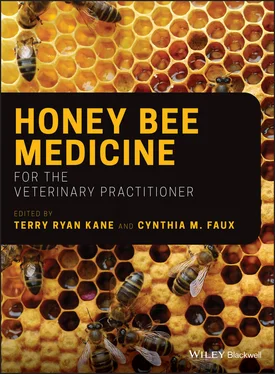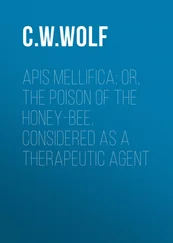Now let us return to those curious observations of populations of mite‐surviving honey bee colonies in various places around the world. A common thread among these reports of populations of honey bee colonies surviving Varroa infestation for long periods without the use of miticides is the isolation of these populations of colonies from managed colonies. The colonies live on islands (Gotland Island in Sweden or the island of Fernando de Noronha off the coast of Brazil), in remote inaccessible regions (far‐eastern Russia), or in an intact forest ecosystem (the Arnot Forest in the northeastern United States). The isolation from managed colonies found in all three of these scenarios must have favored the evolution of avirulence of Varroa and the multitude of viral diseases vectored by this mite. In essence, these populations all lack an important feature that drives virulence of infectious disease – a steady introduction of “S” individuals. With no new “Susceptible” colonies coming into these populations, in each case the mites and the bees have co‐evolved a stable host–parasite relationship. In the case of the Arnot Forest bees, we know the Varroa invasion was associated with significant loss of genetic diversity in the bees (an indicator of heavy colony mortality caused by Varroa), but at the same time the surviving colonies of this population possessed effective defenses against the mites (Mikheyev et al. 2015; Seeley 2017b).
It is here that the “good lifestyle” of colonies occupying small nest cavities, living widely spaced, and swarming frequently meets the “good genes” of colonies that are living as an isolated “island” of colonies. Now that we have married the good genes and the good lifestyle aspects of health in our examination of honey bee management, where does the bee doctor fit into this picture? In the final section of our chapter, we will explore how we can use the knowledge garnered from a deep understanding of wild colonies to develop a new way of keeping healthy colonies in managed apiaries, an approach recently named Darwinian beekeeping (Seeley 2017a).
Lessons from the Wild Bees
Modern apiarists practice pest/disease control, close colony spacing, swarm control, queen rearing, mating control (sometimes), annual requeening of colonies, migratory beekeeping, queen imports, drone reduction, and various other alterations of the bee's natural biology. These apiculture practices tend to limit natural selection and to disrupt the hard‐won adaptations of A. mellifera ; they impact both the genes and the lifestyle of the honey bee (Neumann and Blacquière 2016). Now, what can be done from an animal husbandry and animal health perspective to reverse such trends?
The bee doctor must be prepared to examine honey bee health through a new lens that takes a holistic approach to medicine – one that features an understanding of and appreciation for the health of honey bees living in nature. In some parts of the world, beekeepers are already looking at beekeeping less as a process of domestication that forces the production of honey, wax, propolis, and pollination at great cost to colonies and more as the stewardship of a natural living system. The global decline in bee health is a direct consequence of man's disruption of this system: the introduction of exotic parasites and pathogens, the rise in disease virulence driven by beekeeping practices, and the evolution of drug resistance caused by indiscriminate treatments of colonies. Indeed, it is the pharmaceutical‐centric approach to preventative care for honey bees that is the fundamental reason behind the inclusion of honey bees among the food‐producing animals in North America that now fall under FDA regulations requiring the services of a veterinarian for antibiotic use. A key feature of a healthy system is achieving a balance between the host and the pathogen that promotes host resistance and pathogen avirulence – we can find this balance by promoting good genes and a good lifestyle in the bees.

Figure 1.7 Polyandry, or the multiple matings of a queen with drones from different patrilines, has been associated with colony vigor and improved winter survival. The health benefits of polyandry are linked to improved foraging rates, greater brood production, lower mite infestations, and the possession of rare alleles important for control of infectious disease.
The idea that honey bees have been domesticated by mankind remains a matter of debate. What is clear is that across North America there are populations of wild colonies of A. mellifera that thrive independent of beekeeping activities and that do not require the regular input of new colonies from honey bee swarms arising from managed colonies (Oliver 2014; Seeley 2017b; Radcliffe and Seeley 2018). Furthermore, the wild colonies tend to be genetically distinct from those that queen breeders produce for commercial purposes; the former are both more diverse genetically and they show strong evidence of regional adaptation ( Figure 1.7) (reviewed in Seeley 2019a,b). Evidently, the honey bee colonies managed by beekeepers are semi‐domesticated, since their genes are influenced somewhat by queen breeders and their lifestyle is strongly influenced by their owners (Chapman et al. 2008; Oliver 2014).
An important lesson can be learned from the many animals that man has domesticated over the past thousand years: domestication carries with it a reliance on humans and generally a loss of the ability to survive in the wild. Here we can take some guidance from Charles Darwin:
One of the most remarkable features in our domesticated races is that we see in them adaptation, not indeed to the animal's or plant's own good, but to man's use or fancy. Some variations have probably arisen suddenly, or by one step. However, we cannot suppose that all the breeds were suddenly produced as perfect and useful as we now see them… . The key is man's power of accumulative selection: Nature gives successive variations: man adds then up in certain directions useful to him.
(Darwin 1868)
Among the honey bee traits that are known to have a genetic basis, resistance to disease has shown to be a strong component of colony fitness (Tarpy and Seeley 2006). With this in mind, we believe that both the beekeeper and the bee doctor will be wise to consider the following items when it comes to managing the genetics of honey bees.
Goal 1: Select Locally Adapted, Survivor Stock
Bait hives are a ready method for beekeepers to incorporate wild honey bees and their genes into their apiaries ( Figure 1.8). A queen honey bee of local origin is well suited to an ecoregion or ecotype and has genes that provide a good fit with the local floral diversity, regional environmental conditions (including extremes of temperature, humidity, drought, etc.), and agents of disease.
A wonderful example of the adaptation of honey bees to their locale is the ecotype of A. mellifera that lives in the Landes heathlands of southwestern France (Louveaux 1973). The Landes bees have evolved to have a brood cycle with an unusual, second peak of brood production in August, just in time for the bloom of ling heather ( Calluna vulgaris ) in the Landes landscape. It is interesting to note that when Louveaux moved Paris honey bees to Landes, the Paris bees kept ahead (in colony weight gain, pollen collection, and brood production) of the Landes bees until the middle of July. Up to that point, the Landes bees had trailed behind the Paris bees because the Paris bees had reared more brood in May and June. In August, however, all the colonies of the Landes bees had a second burst of young bees emerging shortly before the heather bloom and by the end of summer these colonies had collected an astonishing 14 kg more honey than the colonies of Paris bees (Louveaux 1973).
Читать дальше













